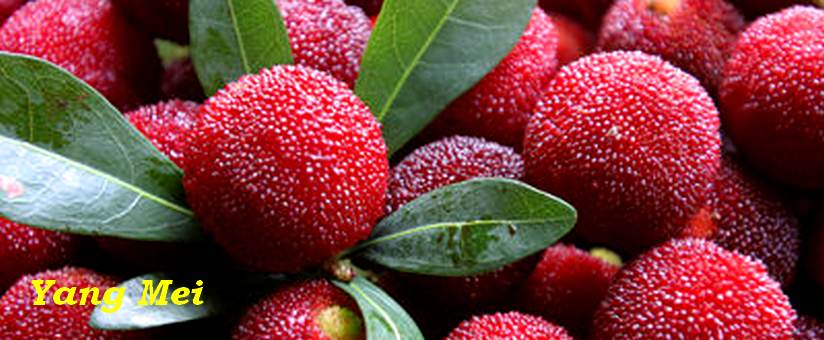

Cina: da un posto qualsiasi..
Yangmei season is usually from mid-May to the end of June, and during this time,
hundreds of thousands are picked along the Yangtze River, and then sold by the kilo everywhere in China.
Though they are called yangmei here, they have a range of different names, both ones that sound scientific,
and those which could have come out of a fairytale:
myrica rubra, arbutus, waxberries, and bayberries.
It can even be called the Chinese strawberry!
I'll stick to the name yangmei throughout this article,
because it is the easiest and simplest name out of all these.
Yangmei are tiny fruits which look like a cross between blueberries and strawberries,
and taste like a mix of blueberries, pomegranate, and cherries:
they are sweet,
pulpy, and slightly sour so that the taste lingers in your mouth long after the you have swallowed them.
You could have eaten them without knowing in countries such as in the U.S., where they are sold as
yumberries and powdered or made into juice.
In China, they are known to have superb health properties:
they contain high levels of antioxidants such as Vitamin C, thiamine, riboflavin and carotene.
In ancient times, they were said to cure many types of stomach illnesses.
Now, studies back up these assumptions, showing that yangmei cleanse the digestive system, as well
as lowering cholesterol and blood pressure levels.
When the first yangmei mature on the trees, you know that the season has begun.
Soon, there will be baskets and baskets of these fruit, showing up in numerous wet markets all over China,
but especially along the area of the Yangtze River, where they are most succulent.
In the Zhejiang province, people put these fruits into anything from cakes,
cookies, and pies, to wine and cocktails.
They are preserved for many months, and even after the summer holidays you see them show up from time to time.
I like them at the very beginning of the season, straight out of the batch,
without any kind of new spice introduced.
However, there are hygiene issues with fresh yangmei, and there must be some procedures done before you
can safely eat them.
Unfortunately, humans aren't the only animals who appreciate this special fruit.
Excluding any animals which may pick them from the tree, there are small flies that live in yangmei
trees and lay eggs on the fruit.
Before eating, it is always best to soak them in salty water for at least half an hour, and some even rinse them
with vodka to make sure they're clean.
The best time to pick yangmei is in the mornings.
During yangmei season, many will organize trips to the hills to look for and pick yangmei.
Venturing out at sunrise, they go out in parties of ten to twenty people to look for the trees harboring these fruits.
As the sun comes out out, the yangmei redden, and become less pulpy and sweet.
When looking for yangmei, you must always choose the dark purple ones,
as they have matured more and are much more delicious.
The deeper the color, the sweeter the yangmei!
I strongly encourage you to taste these special fruits.
Enjoy the yangmei season!
Il " Corbezzolo Cinese" è:
Myrica rubra (Lour.) Siebold & Zucc. è un albero della famiglia Myricaceae, coltivato per i suoi frutti rosso-cremisi
commestibili;
a volte è erroneamente definito come “corbezzolo cinese”.
È chiamato anche Yangmei (cinese: ??S, YángméiP, cantonese: yeung mui; in coreano ?????, sogwinamuLR;
in giapponese:
yamamomo; kanji: ??; katakana: ? ? ? ?, letteralmente "pesca di montagna”.
In inglese è spesso citato come Bayberry Cinese, Bayberry Giapponese, Bayberry Rosso, Yumberry.
Il frutto è sferico, 1,5-2,5 cm di diametro, con una superficie verrucosa.
Il colore della superficie è tipicamente un profondo rosso brillante, ma può variare dal bianco al giallo, al rosso fino al rosso violetto.
Il colore della polpa è simile al colore della superficie, o un po' più chiaro.
Al centro è un singolo seme, di norma allungato-appuntito di dimensione circa la metà del frutto intero.
Sono state sviluppate alcune cultivazioni con frutti più grandi, fino a 4 cm di diametro.
Cortesia di L.B.
